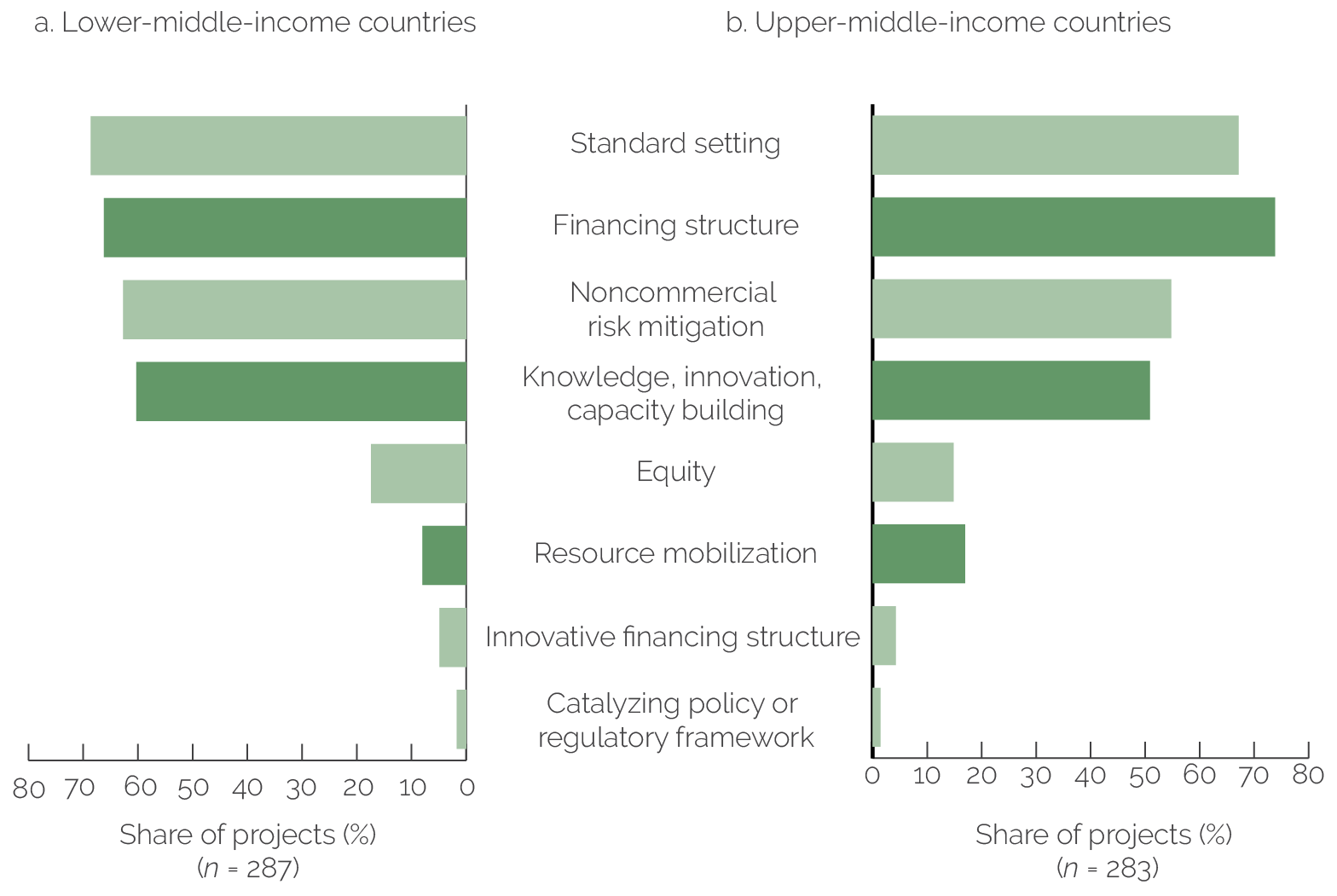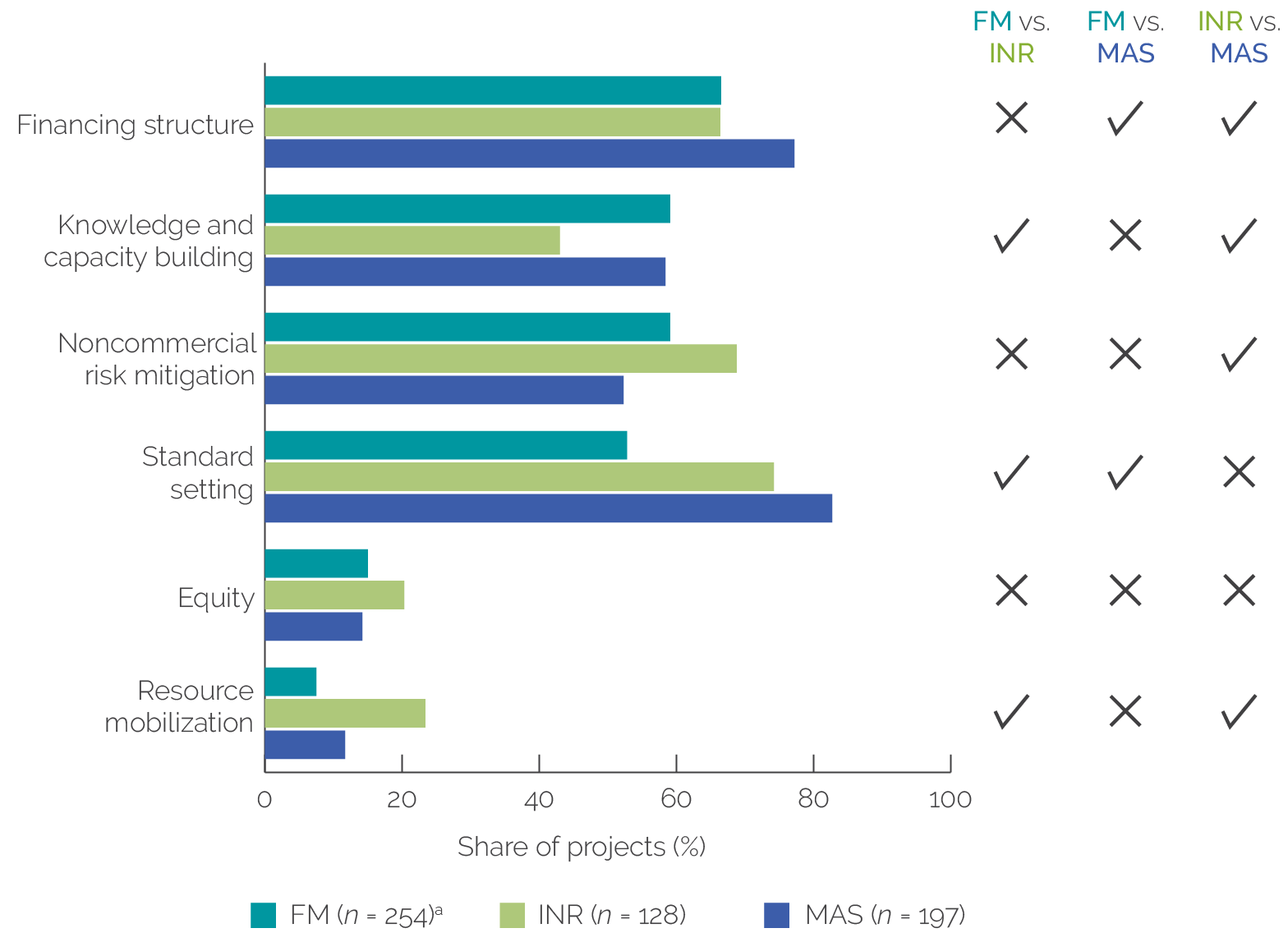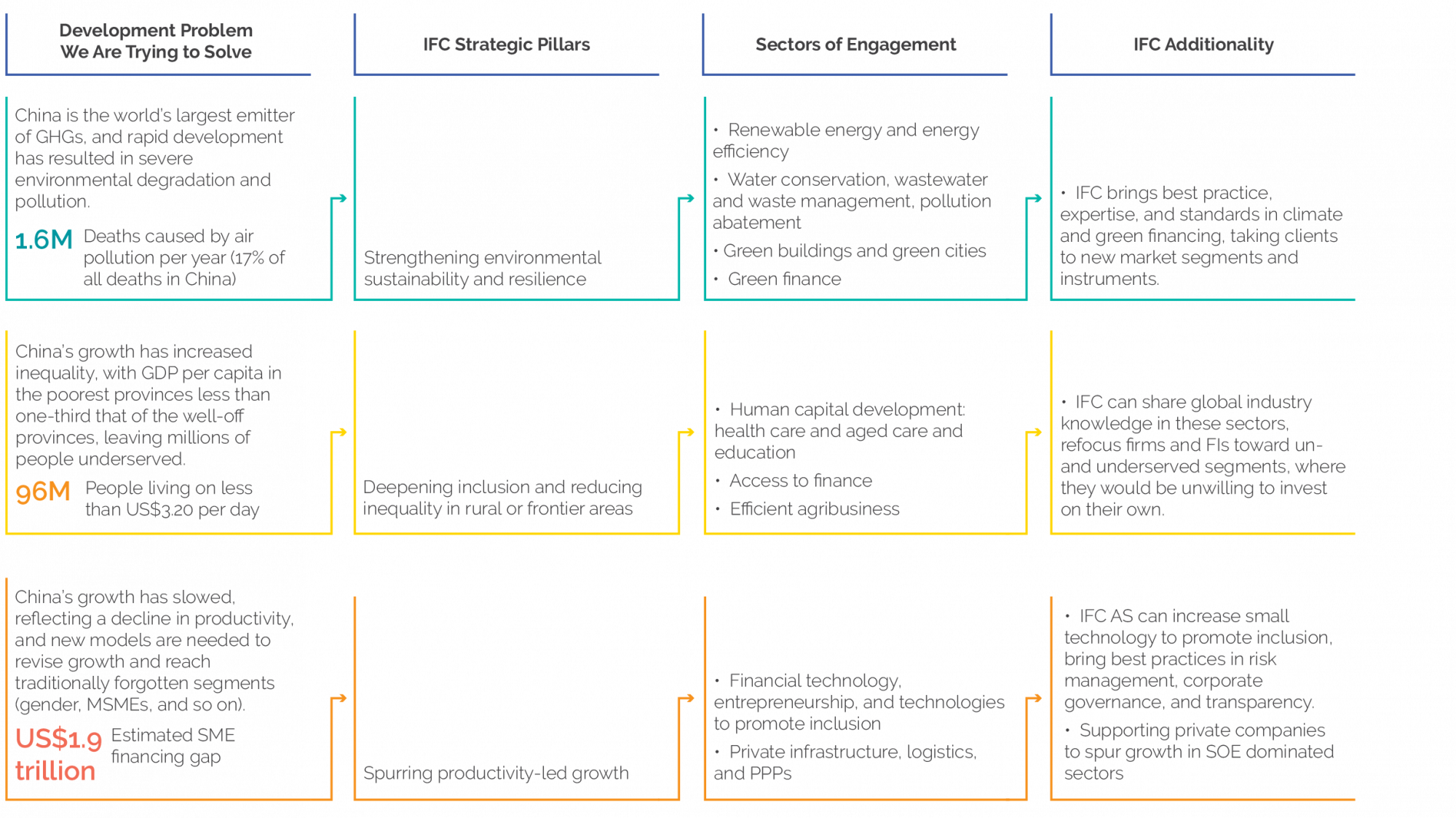International Finance Corporation Additionality in Middle-Income Countries
Chapter 2 | Relevance
Highlights
The chapter assesses the relevance of the approach of the International Finance Corporation (IFC) to additionality in addressing project and country sector needs. It first explores how financial and nonfinancial additionality are identified and articulated in IFC projects and instruments. It then explores the extent to which additionality as articulated in project design responds to the characteristics of projects, clients, sectors, and countries.
Several factors make IFC a leader among development finance institutions in identifying and articulating additionality at the time of approval. IFC’s additionality framework and accompanying guidelines for staff provide the basis for clarity and rigor in articulating additionality in investment project approval documents. Furthermore, its internal review process enhances the quality of additionality claims.
IFC’s additionality at the project level has become more diverse over time to include both financial and nonfinancial attributes. This change has occurred in response to (i) increased availability of private financing, which weakens IFC’s financial additionality, and (ii) increased scrutiny of additionality in projects in upper-middle-income countries. Most projects (82 percent) anticipate both financial and nonfinancial additionality.
The patterns of anticipated additionalities in IFC’s portfolio do not match IFC’s assumptions about how additionality varies based on country income. IFC’s corporate strategies indicate that, as country income rises, IFC will rely more on additionality types based on (financial and nonfinancial) innovation and deployment of knowledge. However, the portfolio tells a different story—IFC has not employed knowledge and innovation additionalities to a greater extent in upper-middle-income countries than in lower-middle-income countries.
The types of additionalities anticipated at the project level differ by sector, suggesting that sector characteristics are and should be considered when planning for additionality. The stage of sector development also influences the types of additionalities provided.
The additionality of IFC’s financing instruments is determined not only by their features but also by the context in which they are applied. The additionality of loans and equity is a function of country, sector, and client risk, and of the stage of market development.
Although IFC has committed only to treating additionality at the project level, the evaluation found that IFC has the potential to add unique value at the country and sector level by discussing and planning for additionality in country and sector strategy documents.
The chapter assesses the relevance of IFC’s approach to additionality in addressing project and country sector needs.1 It first explores how financial and nonfinancial additionality are identified and articulated in IFC projects and embodied in its financial instruments. It then explores the extent to which additionality as articulated in project design responds to the characteristics of projects, clients, sectors, and countries. It looks at how IFC’s anticipated additionality varies depending on these contextual characteristics and whether that variation is aligned with ensuring unique added value. Finally, for learning purposes, the evaluation considers the real and potential value of anticipating additionality beyond the project level.
Additionality at the Project Level
IFC’s additionality framework and the accompanying guidelines provide clarity and rigor in articulating additionality in investment project approval documents. Following IFC’s additionality guidelines, every investment project articulates IFC’s anticipated additionality in Concept Review Meeting notes, Investment Review Meeting documents, and Board Papers. IFC staff confirm that additionality is discussed early in the investment decision process. IFC staff also report a good understanding of additionality and clarity about roles and responsibilities. IEG’s portfolio review confirms that project approval documents systematically address IFC’s anticipated financial and nonfinancial additionality (although specificity varies) and present information in line with internal guidelines.
IFC’s review of anticipated additionality claims ensures the quality and consistency of additionality and development impact statements. The investment team is responsible for presenting IFC’s anticipated additionality and development impact for each transaction. IFC sector economists from the Anticipated Impact Measurement and Monitoring (AIMM)2 team play a substantial role in enhancing quality and reviewing evidence for anticipated additionality claims, as they do for development impact claims. The IFC Global Macro and Market Research team provides data to support anticipated financial additionality claims. In this way, IFC ensures consistency of information between additionality and development impact statements within a project, which is important given the link between these two concepts (as described in chapter 1). Most leading DFIs have similar systems for articulating project-level additionality (box 2.1).
Box 2.1. Project-Level Articulation of Additionality in Development Finance Institutions
Like the International Finance Corporation, other development finance institutions improved articulation of anticipated additionality claims at approval through the 2010s. Additionality is usually discussed along with development impact. In some cases (for example, in the International Finance Corporation and the European Bank for Reconstruction and Development), articulation of anticipated additionality and development impact claims are independent but operate in parallel and are prepared by the same team. In other cases (for example, in the African Development Bank), articulation of anticipated additionality and development impact is done jointly under a single system. European Investment Bank’s Additionality and Impact Measurement system and Inter-American Development Bank Invest’s Development Effectiveness Learning, Tracking, and Assessment tool also fully integrate additionality and development impact.
Among development finance institutions, guidance documents support the articulation of anticipated additionality. These guidelines have improved over time to provide greater clarity about acceptable categories of additionality as per the Multilateral Development Banks’ Harmonized Framework. They have also improved through rating systems (the European Investment Bank), flags and triggers (the European Bank for Reconstruction and Development), and other means to ensure that relevant questions are considered when reaching a view on additionality.
Source: Independent Evaluation Group (see appendix F).
IFC is a leader among DFIs in the identification and articulation of additionality and in providing guidance to staff at the time of approval. IEG concludes this based on its review of how additionality of all types is treated and discussed in Board documents and internal reviews and a comparison of practices across major DFIs. IFC and EBRD have aligned their additionality types with the MDBs’ 2018 Harmonized Framework (ECG 2020). In addition to the framework, IFC has also developed detailed operational guidance that provides investment teams with definitions of each type of additionality and a variety of project examples for each type. Several factors make IFC’s guidelines best practice among the DFIs:
- The level of detail provided in the guidelines;
- The requirement that, for each nonfinancial additionality claim, IFC teams must discuss the mechanism for delivery, such as AS project, industry expert, or the Board appointee;
- The guidance to staff to discuss specifics of the differential support from IFC (IFC 2019b), including the articulation of a counterfactual and development impacts attributable to IFC’s intervention; and
- The establishment of procedures for indicators, delivery, and timing.
IFC’s presentation of additionality in approval documents takes the most comprehensive approach among DFIs (ECG 2020). IFC’s board document template contains a section titled “IFC’s Expected Additionality.” This section lists, classifies, and describes the different types of expected additionalities according to the framework. Indicators (quantitative or qualitative) are also assigned to assess whether a project provided additionality, along with the timing for realization of the specified anticipated additionality. Box 2.2 includes a good-practice example.
Box 2.2. Articulation of Additionality in an International Finance Corporate Renewable Energy Project in a Middle-Income Country
Financial Additionality
Financing structure. The International Finance Corporation (IFC) will provide long-term financing with a maturity of up to 13 years that is not readily available in a country facing considerable macroeconomic and power sector vulnerabilities. The country’s domestic credit to the private sector as a share of gross domestic product, at about 17 percent, lags relevant comparator averages (by region and income group). Over the previous 12 months, only one US dollar–denominated syndicated loan and no local currency–denominated syndicated loans had been provided to a corporation in this country.
Resource mobilization. IFC’s involvement will facilitate the participation of other lenders and provide comfort on the financial sustainability of the power sector, given IFC’s experience investing in independent power providers in the country. Over the previous three years, renewable energy projects had been on hold in the country as a result of regulatory uncertainties until a recent decision to allow projects at an advanced stage of development to proceed under new tariffs. The project will be the first wind project developed after this period of inactivity in the sector.
Nonfinancial Additionality
Risk mitigation. Investor interest has been relatively subdued in recent years because of growing macroeconomic and power sector vulnerabilities in the country. IFC’s involvement in the projects, de facto preferred creditor status as a multilateral institution, and long track record of operating in the country’s power market are expected to provide comfort to investors and help mitigate potential regulatory or political risks.
Knowledge, innovation, and capacity building. The financing is complemented by IFC’s global knowledge in renewable energy, expertise in the country’s energy sector, and ability to use a programmatic approach to increase efficiency in project structuring and preparation. The sponsors will benefit from IFC’s deep experience investing in 18 independent power providers with a total capacity of 5,800 megawatts in the country over the past 25 years. The advisory services team is also exploring with the sponsors the potential for collaboration in addressing community development priorities to bring shared benefits to the local communities, with a special focus on women.
Standard setting. IFC will provide technical support and guidance to help strengthen the sponsors’ capacity to manage environmental and social risks associated with the projects through implementing IFC performance standards. This is important as the sponsors attempt to increase their activity in the energy sector, and, in some cases, this is their first exposure to the power sector. IFC will provide guidance to improve the sponsors’ environmental and social management systems and prepare a biodiversity management plan, including adequate measures to mitigate impacts.
Source: International Finance Corporation board report for a project in a middle-income country.
By contrast with IS projects, AS projects contain limited information about additionality, which constrains accountability and learning. Additionality discussions in AS project approval documentation have varied substantially over time. At some points during the evaluation period, additionality-related information was included in approval documents. It was then moved to early approval documents (Concept Notes), later disappeared, and more recently, has been brought back. Only at the time of project closure does some discussion of additionality occur in evaluations under the category “role and contribution,” which is a broader concept than additionality. Whereas investment projects switched from the role and contribution concept to additionality in 2018, AS has neither made that transition nor updated the definition or guidelines for role and contribution since the inception of AS project governance in the early 2000s. The lack of detail and consistency in IFC AS documents limits learning and accountability, as evidenced by IEG’s inability to conduct a portfolio analysis similar to the one for investments because of the lack of consistent information on anticipated additionality.
Types of Anticipated Additionality at the Project Level
Claims of anticipated nonfinancial additionality in IFC’s investment portfolio in MICs have increased in number and diversity over time. IFC’s additionality framework states that IFC value addition to clients has broadened over time to include both financial and nonfinancial additionality. Indeed, IFC staff’s perceptions align with IFC’s corporate strategic view that nontraditional forms of additionality are important to IFC’s relevance in MICs. Staff perceive that to attract clients in more developed markets, IFC must supplement the traditional financial additionality based on financing structure with other forms of financial additionality (mobilization, innovation) and nonfinancial additionality (such as standard setting, knowledge, innovation, and capacity building). IFC staff also report greater scrutiny by the Board and management of additionality claims in MICs, particularly UMICs. This implies that the requirements for additionality are more stringent in UMICs. Meeting them is usually achieved through reliance on nonfinancial additionalities in addition to financial ones.
Most investment projects anticipate both financial and nonfinancial additionality. Eighty-two percent of investment projects evaluated in 2011–21 anticipated both financial and nonfinancial additionality. This was up from 78 percent in 2011–12 and only 41 percent in 2008–11 (World Bank 2015).
Figure 2.1. Anticipated Financial and Nonfinancial Additionality by Subtype: Investment Projects

Source: Independent Evaluation Group portfolio review.
Note: This figure does not include the distribution of additionalities considered in projects approved when Nigeria and Bangladesh were still low-income countries.
Anticipated nonfinancial additionality is more diverse than anticipated financial additionality. Financial additionality still relies, in most cases, on the financing structure subtype (figure 2.1, panel a). Financing structure additionality, in turn, relies mostly on provision of long-term funds (present in 74 percent of financing structure additionalities). Equity and resource mobilization represent a small percentage of anticipated financing structure additionalities (14 percent and 11 percent, respectively), and the use of innovative financing structures is rarer (4 percent of financing structure additionalities). The distribution of anticipated nonfinancial additionality subtypes is more balanced (figure 2.1, panel b). Standard setting is the most common anticipated nonfinancial additionality (41 percent of nonfinancial additionalities). Noncommercial risk mitigation and knowledge and capacity building are represented in 30 percent and 28 percent of nonfinancial additionalities, respectively. Standard setting is mainly focused on E&S standards (present in 64 percent of projects anticipating standard setting additionalities). In contrast, corporate governance standards are less common (present in 27 percent of standard setting projects).
Additionality by Instrument
The additionality of IFC’s instruments is determined not only by their features but also by the context in which they are deployed. The additionality of instruments such as various types of loans and equity is a function of country, sector, and client risk and stage of market development.3 For instance, common equity is usually additional only in unlisted clients in LMICs and not additional in UMICs. However, in times of financial crisis, IFC common equity may become additional for listed clients in UMICs when used in instances where investors attempt to reduce their risk by selling their equity positions (table 2.1). Similarly, short-term working capital loans are additional in some LMICs because of IFC’s ability to supply credit to firms that do not have acceptable collateral, such as land titles. Furthermore, when LMIC markets face liquidity problems, such as during a credit crisis (as they did during COVID-19), short-term loans can be highly additional because of the lack of alternatives in the market, even to the point of enabling a firm to avoid default or bankruptcy. In all countries, IFC’s short-term US dollar credit lines to banks and other financial institutions can be highly additional in times of currency devaluation, when access to US dollar liquidity may be extremely limited.
Table 2.1. Additionality of Selected Equity Instruments
|
Equity Instruments |
Main Sources of Financial Additionality in LICs |
Main Sources of Financial Additionality in LMICs |
Main Sources of Financial Additionality in UMICs |
|
Common equity Unlisted (pre-IPO) Listed (post-IPO) |
|
|
|
|
Preferred equity Unlisted Listed |
|
|
|
|
Equity-linked options Puts Calls |
|
|
|
Source: Independent Evaluation Group (see appendix E).
Note: IFC = International Finance Corporation; IPO = initial public offering; LIC = low-income country; LMIC = lower-middle-income country; UMIC = upper-middle-income country.
Additionality by Country Income
IFC’s corporate strategies indicate that, as country income rises, so too will the innovation and knowledge content of IFC engagements. Several IFC strategy documents acknowledge that IFC’s value added and activities in MICs generally and UMICs in particular will differ from those in LICs. IFC’s 2012–14 road map, presented to the Board of Executive Directors, proposed a conceptual framework where, as the income level of countries rose, IFC would move to frontier markets and regions, take on more innovative projects, and address crises and global priorities (IFC 2011). Thus, to some extent in LMICs and to a greater extent in UMICs, additionality based on innovation (financial and nonfinancial) and deployment of knowledge was framed as key to enhancing development impact. IFC 3.0 poses MICs as a kind of laboratory for IFC where it can “utilize MIC work to prove out concepts and then transfer them to [the International Development Association / fragile and conflict-affected situations]” (IFC 2015; 2016, 41). IFC’s strategy for 2020–22 indicates that in MICs IFC will focus on “selectivity, innovation[,] and profitability” (IFC 2019c, 36), the latter to ensure IFC’s financial sustainability.4 IEG’s interviews with IFC experts confirm an understanding that nonfinancial additionalities should play a stronger role in more sophisticated markets.
However, the portfolio tells a different story—the patterns of anticipated additionalities in IFC’s portfolio do not match IFC’s assumptions about how additionality varies based on country income. IFC additionality has not employed knowledge and innovation additionalities to a greater extent in UMICs than in LMICs. IFC has a higher share of anticipated financial additionalities in UMICs than in LMICs and more anticipated nonfinancial additionalities in LMICs than in UMICs. Statistical analysis (at the 95 percent confidence level) shows that financial additionality features such as financing structure and resource mobilization are more prominent in UMICs (present in 74 percent and 17 percent of projects, respectively) than in LMICs (66 percent and 8 percent, respectively). None of the nonfinancial additionalities have a significantly higher incidence in UMICs. However, two key nonfinancial additionalities (knowledge and noncommercial risk mitigation) have a higher incidence in LMICs than in UMICs (figure 2.2). Furthermore, additionality claims in UMICs do not show a higher incidence of innovation. For example, additionality based on innovative financing structure has a low incidence in both UMICs (4 percent) and LMICs (5 percent).
Figure 2.2. Incidence of Additionality Subtypes, Lower-Middle-Income Countries Compared with Upper-Middle-Income Countries
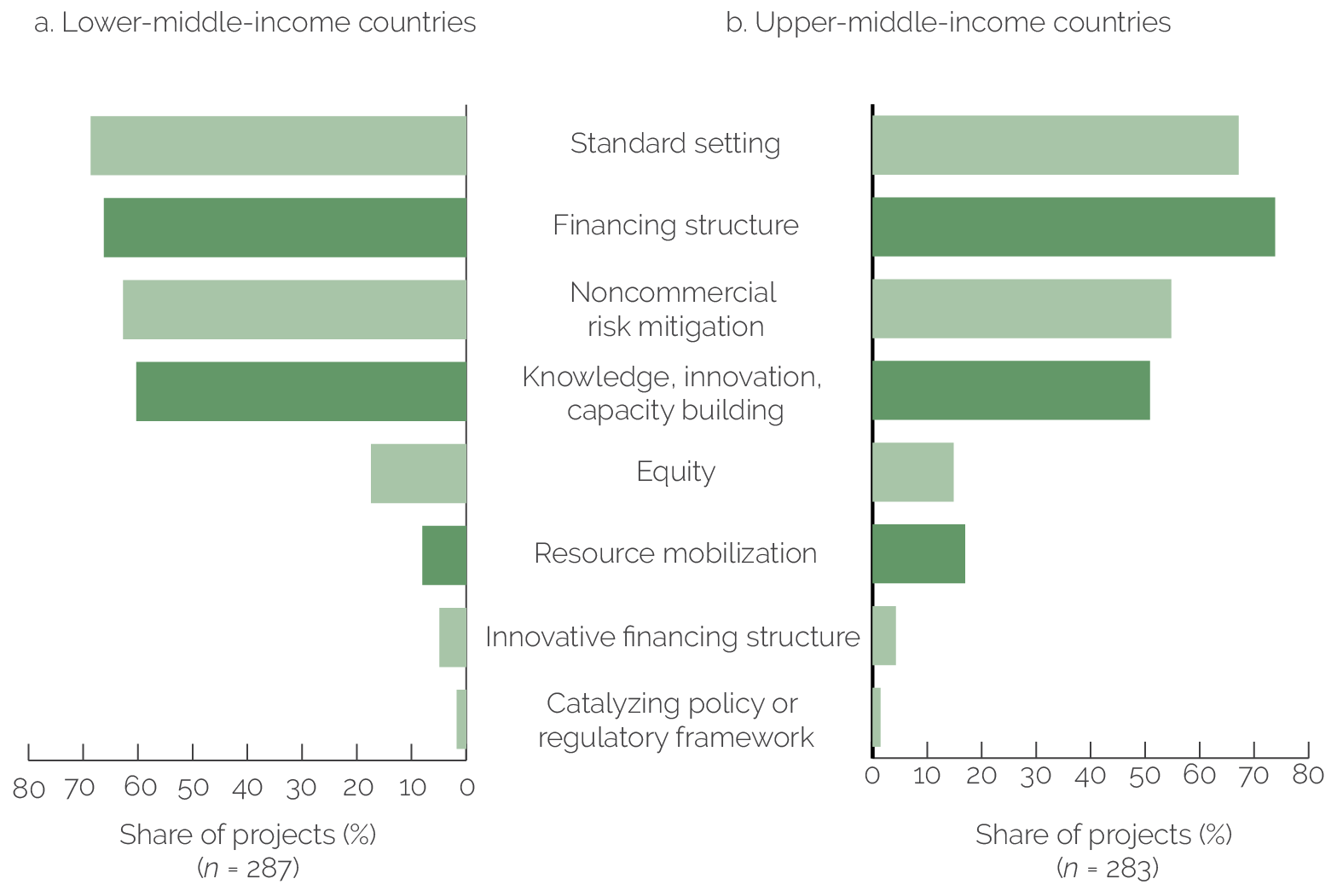
Source: Independent Evaluation Group.
Note: Dark green indicates additionality types for which differences between upper-middle-income countries and lower-middle-income countries are statistically significant at 95 percent.
Additionality by Sector
The differences between anticipated additionality types by sector are statistically significant, suggesting that IFC may be adapting to sector characteristics when planning for additionality.5 By IFC industry group, Manufacturing, Agribusiness, and Services (MAS) and Infrastructure (INR) rely more on standard setting, mostly E&S, than does financial markets (figure 2.3). This differing reliance on standard setting makes sense because, in INR and MAS, IFC is more exposed to E&S risks and must ensure clients’ compliance with multiple E&S standards (for example, pollution, labor, and safety). In financial markets projects, IFC only has to ensure that clients set up internal E&S management systems to manage risks associated with their subprojects. As an example of the factors influencing greater reliance on standard setting in MAS projects, IFC helped a manufacturing client in the Russian Federation design its corporate policies and guidelines. At the same time, it also supported the company in addressing issues related to air emissions, wastewater treatment, and workers’ health and safety. MAS relies more on financing structure than financial markets and INR because MAS projects are highly variable in terms of the type of project, subsector, and local conditions (which requires careful customization of the financing). By contrast, INR relies mostly on noncommercial risk mitigation and resource mobilization. The large size of INR projects means that IFC’s resources alone are insufficient.6 Therefore, IFC plans to either (i) directly mobilize additional funding from other DFIs or private investors (resource mobilization) or (ii) indirectly motivate other investors’ financing (noncommercial risk mitigation). For example, for an INR project of $166.6 million in Jordan, IFC mobilized $72.6 million through subordinated and parallel loans.
In certain instances, the stage of sector development influences the types of additionalities provided. In Nigeria, for example, IFC entered the microfinance sector at an early stage of its development. IFC’s main additionality was financial structuring through the provision of loans to local microfinance institutions. IFC also relied heavily on building knowledge and capacity (through AS) to create, develop, and strengthen institutions. By contrast, once a sector reaches maturity, IFC must innovate to continue to be additional and attractive to clients. The commercial banking sector in Türkiye is a good example. IFC’s clients in Türkiye are strong banks with good capitalization and sound practices with little need for regular financing or knowledge and capacity support. With these clients, IFC deploys innovative financing products (for example, derivatives and green bonds) deemed too risky or unattractive for regular investors; nonfinancial additionality is limited to regular E&S standards.
Figure 2.3. Anticipated Additionalities by Sector and Type
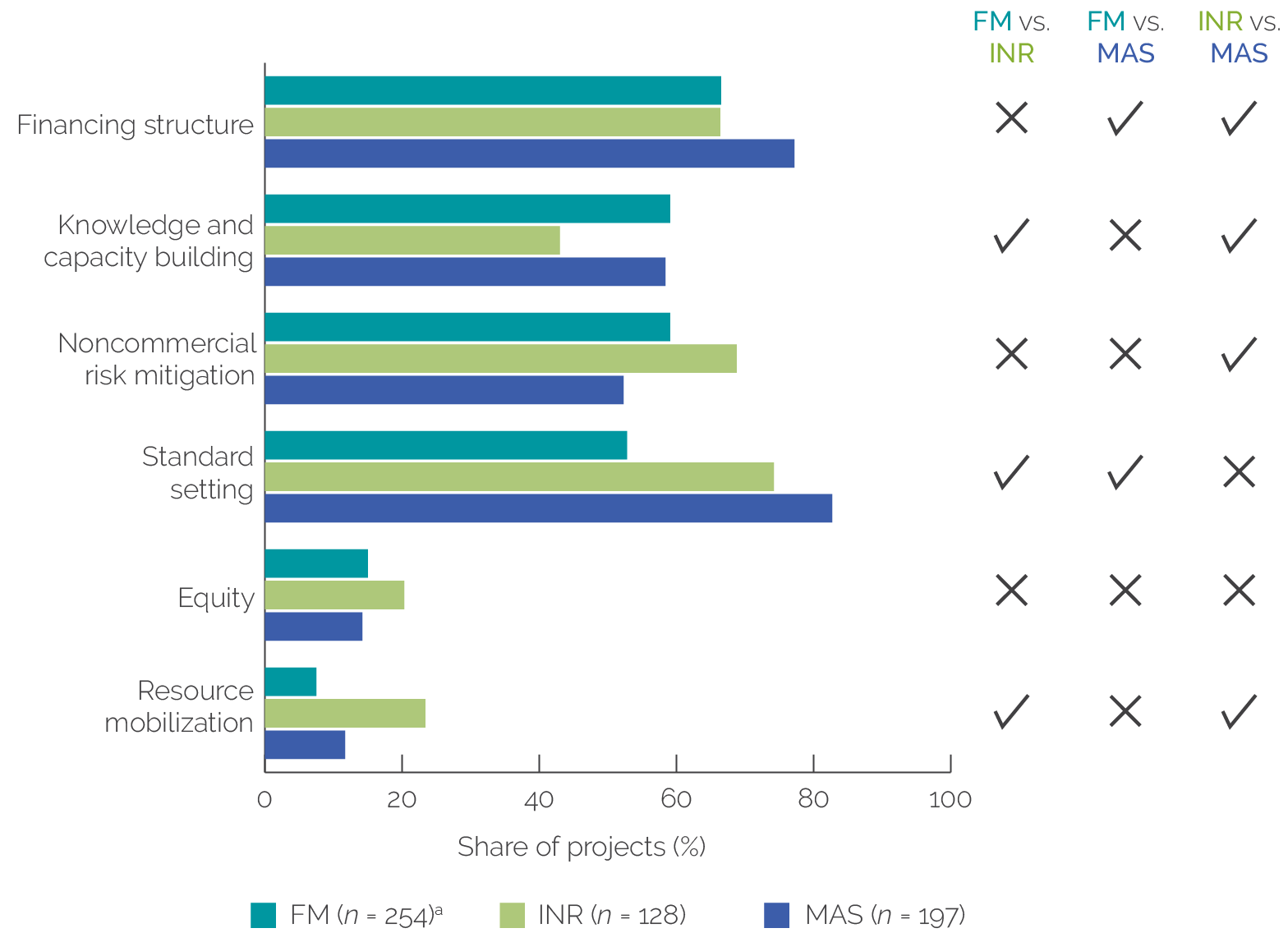
Source: Independent Evaluation Group portfolio analysis.
Note: The figure includes only subtypes representing more than 5 percent of projects in all sectors. Check marks indicate that differences between sectors are statistically significant at the 95 percent confidence level. FM = financial markets; INR = Infrastructure; MAS = Manufacturing, Agribusiness, and Services.a. FM includes projects by the Financial Institutions Group and Disruptive Technologies and Funds.
Additionality in Strategies: Beyond the Project Level
Although IFC has only committed to identifying additionality at the project level, it also, at times, discusses additionality at the country and sector level.7 Some IFC country and sector strategy documents include discussions about additionality patterns in LMICs and UMICs—the evaluation found a few examples of a higher-level strategic approach to additionality beyond the project (see chapter 3).8 In such approaches, IFC presents its unique value added at the country or sector level and is explicitly attempting to add value through a combination of activities in a sector or country that are complementary, sequenced, or coordinated with other actors.
IFC country strategies and sector deep dives show the potential of beyond-the-project strategic planning for additionality. IFC and World Bank Group country strategy documents for China show how the articulation of IFC’s additionality was well addressed and became more explicit over time. The anticipated additionality and its sources in the 2013–16 Country Partnership Framework (CPF) had to be inferred because IFC’s additionality, value added, or competitive advantages were not explicitly discussed (World Bank 2012). The 2020–25 CPF improved by identifying key IFC financial and nonfinancial additionalities (World Bank 2019). Finally, IFC’s own country strategy FY20–24 demonstrates a best practice model in its explicit treatment of additionality and identification of additionality types by sector (figure 2.4; IFC 2019a). For example, the country strategy specifies IFC additionality in addressing greenhouse gas reduction, enhancing equality, and increasing productivity. IFC’s sector deep dives also show the benefits of thinking about IFC’s additionality (or unique valued added) beyond the project level. In housing, for example, the sector deep dive identifies IFC’s ability to bring best practice standards and innovative financing, both subtypes of additionality, to bear. In financial technology (fintech), IFC envisions how its AS can be deployed to add knowledge benefits in areas including risk management and corporate governance.
Figure 2.4. International Finance Corporation Additionality in International Finance Corporation’s Country Strategy for China
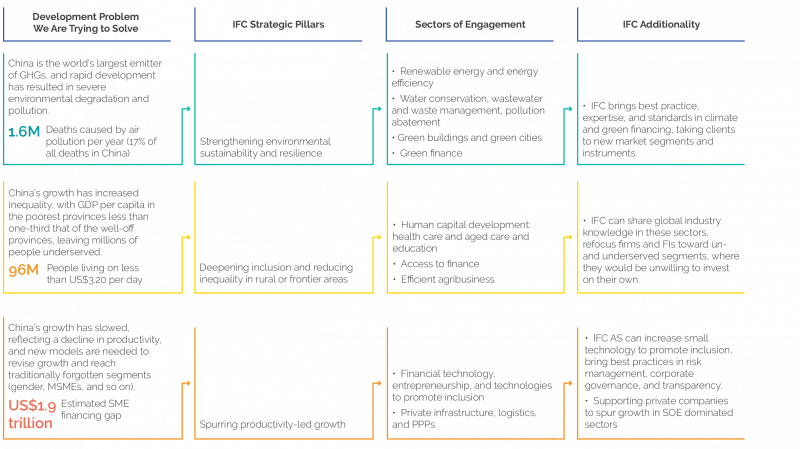
Source: International Finance Corporation 2019a.
Note: AS = advisory services; FI = financial institution; GDP = gross domestic product; GHG = greenhouse gas; IFC = International Finance Corporation; MSME = micro, small, and medium enterprise; PPP = public-private partnership; SME = small and medium enterprise; SOE = state-owned enterprise.
- According to the Development Assistance Committee of the Organisation for Economic Co-operation and Development, the relevance criterion for evaluation answers the question, “Is the intervention doing the right things?” by evidencing “the extent to which the intervention objectives and design respond to beneficiaries, global, country, and partner/institution needs, policies, and priorities, and continue to do so if circumstances change” (OECD, 2019, p. 7).
- The Anticipated Impact Measurement and Monitoring system allows the International Finance Corporation (IFC) to define, measure, and monitor the development impact of each project. The Anticipated Impact Measurement and Monitoring system is integrated into IFC’s operations, allowing development impact considerations to be weighed against a range of strategic objectives, including volume, financial return, risk, and thematic priorities (https://www.ifc.org/wps/wcm/connect/topics_ext_content/ifc_external_corporate_site/development+impact/aimm).
- Independent Evaluation Group (IEG) deep dive: additionality of IFC’s financial products (summarized in appendix F).
- The World Bank Group capital increase document states: “[Upper-middle-income countries] provide IFC lower expenses and better return on capital than the IFC average and can offset underperformance in less financially sustainable environments, such as in [fragile and conflict-affected situations] and low-income [International Development Association] countries” (World Bank 2018, 12). This document also states that, for upper-middle-income countries above graduation discussion income, “IFC commits to apply rigorous additionality assessment for its investments, and aims to focus on global public goods, frontier regions, capital markets, and south-south partnerships” (World Bank 2018, 16).
- Differences among sectors discussed in this paragraph are statistically significant at the 95 percent confidence level.
- Based on investment projects evaluated during 2011–21.
- The IEG recognizes that IFC management has committed to additionality principles only at the project level. This evaluation’s added lenses of country and sector level are applied to add to learning from IFC’s experience and build on existing IFC practices observed during the evaluation. However, the intent is purely learning—there is no accountability aspect of this coverage.
- In a review of the nine country strategies for case study countries and an additional six sector deep dives, the IEG found that the treatment of IFC’s additionality ranged from very insightful to absent. IFC, like most multilateral development banks, generally does not discuss additionality in its strategic documents.



